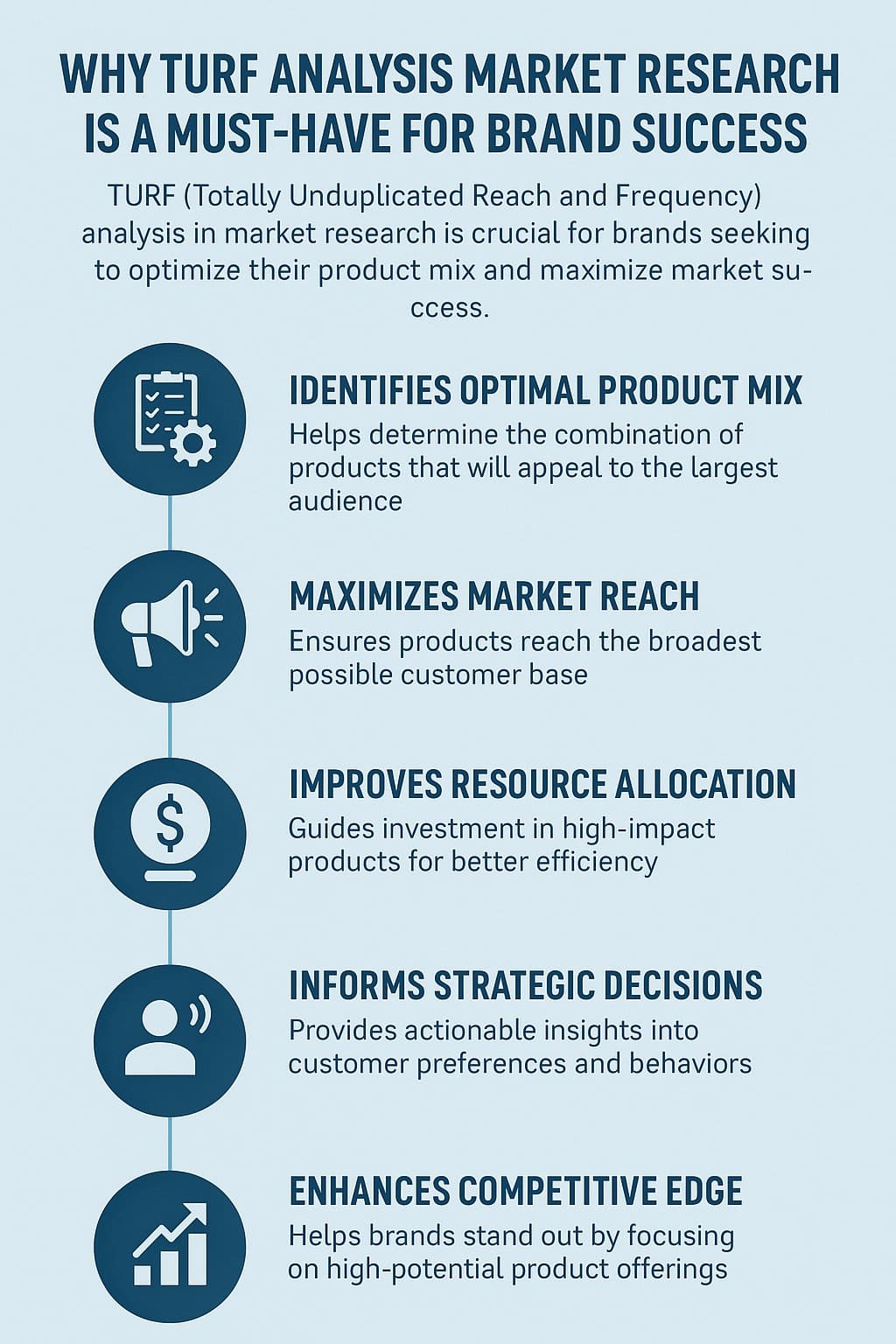TURF Analysis Market Research

Most new products fail not because they’re bad, but because companies fundamentally misunderstand how consumers make choices in competitive markets.
Have you ever launched a product that you were absolutely certain would dominate the market, only to watch it crash and burn while your competitors somehow managed to thrive?
Most researchers have!
Back in 2004, a leading consumer packaged goods company was convinced its new premium product line would revolutionize its category. Their traditional market research checked all the boxes: strong concept testing scores, enthusiastic focus groups, and solid purchase intent. The executive team was practically popping champagne bottles before launch.
Six months later, they wrote off inventory and explained the fiasco to shareholders.
What went wrong? They completely missed the brutal reality of how their product would actually perform in a crowded, competitive landscape. They never ran turf analysis market research—and paid dearly for that oversight.
Table of Contents
✅ Listen to this PODCAST EPISODE here:
What Is Turf Analysis Market Research?
TURF stands for Total Unduplicated Reach and Frequency. Don’t let the technical name intimidate you. Turf analysis market research is simple: it helps you understand how different product offerings compete for the same customers, and how to maximize your market coverage with minimal cannibalization.
Think of it this way: traditional research asks, “Do people like my product?” Turf analysis market research asks, “Will people actually choose my product over everything else available to them, and if so, which specific customers am I winning, and which ones am I losing to competitors?”
The difference is everything.
Unlike many research methodologies, turf analysis market research is ruthlessly practical. It doesn’t deal with hypotheticals or abstractions. It simulates the actual choices consumers make in competitive environments and predicts market outcomes with remarkable accuracy.
How Turf Analysis Transforms Market Research Data

Most research methodologies give you a fuzzy snapshot of consumer attitudes. Turf analysis market research gives you a high-definition simulation of the battlefield where your products actually compete.
When you show consumers a concept and ask if they like it, most will say yes. When you ask if they’d consider buying it, many will say yes to that too. These inflated scores create a false sense of security that has bankrupted countless companies.
Turf analysis market research shatters these illusions by forcing consumers to make trade-offs—just as they do in real life. It acknowledges the mathematical reality that consumers can’t buy everything they find “appealing.” They must choose, and those choices reveal their true preferences in ways that conventional questioning never will.
The power of turf analysis market research comes from its ability to show preference hierarchies and trade-offs. It doesn’t just tell you if your product is good—it tells you if it’s good enough to win in its competitive context.
Key Benefits of Turf Analysis in Market Research
The most immediate benefit? Ruthless prioritization amid complexity. In today’s feature-rich environment, the temptation is to add more—more product variants, features, and services. Turf analysis market research cuts through this complexity by quantifying each potential addition’s exact reach and preference impact.
Another game-changing benefit is the ability to identify inefficiencies in product portfolios and marketing efforts. Traditional research often leads companies to maintain bloated product lines where newer offerings cannibalize older ones without expanding overall market share.
There’s also the benefit of competitive war gaming. Turf analysis market research allows companies to prepare contingency plans for likely competitive reactions by modeling how different competitive responses might impact preference shares. Finally, optimizing product configurations and marketing efforts has a substantial financial impact. As noted in industry publications, companies using advanced methodologies like turf analysis routinely reduce product development costs by 15-40% while simultaneously improving market performance.
Implementing Turf Analysis in Your Research Strategy

First, recognize that turf analysis isn’t just another survey question you tack onto existing research. It requires a fundamentally different approach to research design. The core of turf analysis market research is simulating choice in competitive contexts, which means you need to present respondents with realistic choice scenarios that reflect the actual market environment.
Start with clearly defining the competitive set your offering will face. This sounds obvious, but countless companies delude themselves by excluding key competitors from their analysis. Be brutally honest here—include every alternative that your target customers might reasonably consider, including the option to purchase nothing at all.
Next, develop a research design that forces choice rather than just collecting ratings. This typically involves:
- Discrete choice experiments where respondents must select from competitive alternatives
- Max-diff exercises to establish preference hierarchies
- Sequential choice scenarios that simulate real shopping or selection experiences
- Share allocation exercises where respondents distribute limited resources across options
The magic happens in how you structure these trade-off scenarios. Traditional approaches ask, “Would you buy this?” Turf analysis market research asks, “Which ONE of these would you choose if these were your only options?” It’s a subtle but crucial difference.
Implementation typically spans 3-8 weeks depending on complexity and sample requirements. The most successful programs follow this sequence:
- Competitive landscape mapping to identify all relevant alternatives
- Choice scenario development that realistically reflects market conditions
- Data collection using a representative sample of target customers
- Simulation modeling to predict market behavior under various conditions
- Optimization analysis to identify winning configurations and strategies
- Sensitivity testing to assess vulnerability to competitive responses
- Action planning tied directly to maximizing reach and preference
The common pitfall? Overthinking the analysis while underthinking the strategic implications. It is common to see companies get so fascinated with the mathematical elegance of their turf models that they forget the whole point, which is to make better business decisions. A good turf analysis should directly inform:
- Which products or features to prioritize
- How to optimize your portfolio to maximize reach
- Where to focus marketing resources for greatest impact
- Which market segments offer the best opportunity for growth
- How to position offerings against specific competitive threats
Advanced Techniques: Taking Turf Analysis to the Next Level
For those ready to move beyond basic applications, there’s a whole universe of advanced turf analysis market research approaches that can extract even deeper insights from your data. These aren’t just academic exercises—they’re battle-tested techniques that have created massive competitive advantages for our clients.
Dynamic turf modeling represents one of the most powerful evolutions of traditional analysis. Rather than creating static simulations, this approach incorporates how preference structures change in response to competitive moves, pricing shifts, or market conditions. When we implemented dynamic turf analysis market research for a technology client, we were able to simulate how their market share would evolve over multiple product generations and competitive response cycles. This long-term view allowed them to make strategic investments that appeared suboptimal in the short term but created substantial competitive advantages over a three-year horizon.
Segment-specific turf modeling offers particularly powerful insights by recognizing that preference structures often vary dramatically across customer segments. For a financial services client, we built separate turf models for five key customer segments, revealing that product features that increased preference in one segment actively decreased it in others. This insight led to a completely redesigned product strategy with targeted offerings for each segment rather than a one-size-fits-all approach.
Perhaps most exciting is the integration of turf analysis market research with AI and machine learning. These technologies can process vastly larger competitive sets and identify subtle interaction effects human analysts might miss. A retail client using these advanced techniques discovered counter-intuitive feature combinations that created disproportionate preference increases when offered together—insights that transformed their product development roadmap.
Common Challenges and How to Overcome Them

You’ll face implementing turf analysis market research. You will probably encounter every one of these barriers, and there’s no value in pretending implementation is simpler than it actually is.
Complexity management presents perhaps the biggest initial hurdle. Full-scale turf analysis can quickly become unwieldy as the number of product variants, features, or competitive alternatives increases. When a consumer goods client faced this exact problem with 32 potential product configurations, we addressed it by using a tiered approach—first conducting a high-level analysis to identify the most promising configuration clusters, then running detailed turf analysis only on those clusters. This staged approach reduced analytical complexity while still delivering actionable insights.
Data quality challenges are also common, particularly around competitive offerings. Effective turf analysis market research requires accurate representation of competitive alternatives, but many companies have remarkably poor competitive intelligence. To address this, we now begin implementations with a competitive audit that systematically documents the relevant attributes of all significant alternatives in the market. This foundation-building step may add time upfront but prevents garbage-in-garbage-out scenarios that undermine the entire analysis.
Organizational resistance can also become a major barrier, particularly when turf analysis market research contradicts established beliefs or challenges pet projects. Despite overwhelming evidence, many product managers refuse to accept results showing their innovations would fail in competitive contexts. To navigate this political minefield, we now begin with expectation-setting workshops where key stakeholders acknowledge the possibility that cherished assumptions might be wrong. Establishing this openness to evidence-based course correction before seeing results significantly improves implementation success.
Perhaps the most insidious challenge is the temptation to manipulate the competitive context to generate more favorable results. Sometimes, marketing teams try to exclude key competitors or misrepresent competitive offerings to make their products look better in simulation. This self-deception is lethal.
As case studies have shown, organizations that successfully overcome these challenges create sustainable competitive advantages through superior market understanding.

Punti chiave
✅ Turf analysis market research reveals not just what consumers like, but what they’ll actually choose when faced with competitive alternatives and forced to make trade-offs
✅ This approach transforms traditional product testing into realistic market simulations that predict competitive outcomes with far greater accuracy than conventional methods
✅ Implementing effective turf analysis requires carefully designed choice scenarios that realistically reflect the competitive landscape consumers actually face
✅ Advanced applications including dynamic modeling, segment-specific analysis, and AI-enhanced simulation are dramatically expanding the predictive power and strategic application of this methodology
✅ Common implementation challenges include complexity management, data quality issues, and organizational resistance to uncomfortable truths about market potential
✅ Future trends point toward real-time, integrated models that combine stated preferences with observed behaviors for unprecedented predictive accuracy
What Makes SIS International a Top Turf Analysis Provider?
When you’re selecting a partner for turf analysis market research, methodological expertise isn’t just a nice-to-have—it’s everything. After four decades pioneering these approaches across industries and continents, here’s what actually differentiates our capability:
✔ GLOBAL REACH: Most market research firms claim “global capabilities” while actually deploying standardized methods across diverse markets. Our teams have on-the-ground presence in 120+ countries, capturing the unique competitive dynamics and preference structures in each market.
✔ 40+ YEARS OF EXPERIENCE: We’re not just applying textbook methodologies—we’ve helped develop them. Since implementing our first turf models in the early 1980s, we’ve refined these approaches through thousands of projects across virtually every product category.
✔ GLOBAL DATA BASES FOR RECRUITMENT: Effective turf analysis depends entirely on capturing preferences from representative samples of your target market. Our proprietary respondent databases give us unrivaled access to specialized consumer and B2B segments others can’t reach.
✔ IN-COUNTRY STAFF WITH OVER 33 LANGUAGES: Competitive dynamics are inherently cultural and linguistic. Subtle product attributes that drive preference in one market may be irrelevant in another. Our native researchers capture these nuances that would be completely missed by translated research.
✔ GLOBAL DATA ANALYTICS: Our dedicated analytics teams specialize in every variant of turf methodology, from traditional unduplicated reach analysis to sophisticated agent-based models and machine learning applications.
✔ AFFORDABLE RESEARCH: Our global scale and methodological efficiency allow us to deliver sophisticated turf analysis at price points significantly below typical management consulting rates.
✔ CUSTOMIZED APPROACH: We don’t believe in one-size-fits-all methodologies. Each turf analysis project is tailored to your specific market questions, competitive landscape, and implementation context.
Domande frequenti
What exactly is turf analysis in market research?
Forget the technical definition. Turf analysis market research is a way to predict what will actually happen when your product faces real competitors in the marketplace—not what consumers claim they’ll do in artificial research environments. It creates a mathematical simulation of competitive choice that reveals which products or features consumers will select when they can’t have everything.
While traditional research might tell you that 70% of consumers “like” your product, turf analysis shows you that only 12% would actually choose it over competitive alternatives. This reality check is why turf analysis market research has become essential for any company operating in competitive categories. It doesn’t just tell you if your product is good; it tells you if it’s better than the alternatives in ways that matter to consumers with limited time, attention, and money.
How does turf analysis differ from other market research methods?
Most research methods create dangerous illusions. Concept tests show inflated scores because consumers evaluate products in isolation. Purchase intent measures are notoriously unreliable because claiming you’ll buy something costs nothing. Focus groups capture rationalized opinions rather than actual choice behavior. Turf analysis market research is fundamentally different because it forces the trade-offs that define real-world markets.
Traditional methods might tell you consumers value certain features—turf analysis shows you which features actually drive preference versus competitors. Standard approaches measure attitudes—turf analysis predicts behavior. It’s the difference between knowing what consumers say they’ll do and predicting what they’ll actually do when facing competitive alternatives. The mathematical reality is that no consumer can buy everything they find “appealing,” and turf analysis is the only standard methodology that fully acknowledges this fundamental constraint.
What types of business questions are best answered using turf analysis?
Turf analysis market research shines when you need to optimize resource allocation in competitive contexts. It’s ideal for questions like: Which combination of features will maximize our market share against specific competitors? How should we configure our product line to reach the most customers with the fewest variants? Which market segments offer the greatest opportunity given the competitive landscape? How will adding or removing specific product attributes impact our competitive position? What is our true market potential given existing competitive alternatives?
How much data do we need to create reliable turf analysis?
The required sample size depends on the complexity of your competitive landscape and the granularity of insights needed. For standard applications with relatively straightforward competitive sets, robust results typically require 300-500 respondents. More complex scenarios with numerous product variants or detailed segment analysis may require 800-1,200 respondents for statistical reliability. The critical factor isn’t just sample size but sample composition—ensuring you’re capturing preferences from a truly representative sample of your target market.
Can turf analysis help with pricing strategy?
Absolutely—it’s one of the most powerful applications. Traditional pricing research tells you how price affects purchase likelihood for your product in isolation. Turf analysis market research shows how price changes affect your competitive position relative to alternatives. This distinction is crucial. A luxury fashion client discovered through traditional research that lowering prices would increase purchase intent.
However, our turf analysis revealed something counterintuitive: price reductions actually decreased their preference share in their core affluent segment because it changed brand perception and competitive positioning. Conversely, a B2B software provider learned that a 15% price premium over competitors had virtually no impact on preference share for certain customer segments where their differentiated features were highly valued.
How long does it take to implement turf analysis?
For projects using well-defined competitive sets and standardized methodologies, expect 3-5 weeks from initiation to actionable insights. More complex scenarios involving extensive competitive assessment or custom methodologies typically require 6-10 weeks.
Implementation of the resulting insights varies dramatically based on what you discover and your organization’s agility. That said, one advantage of turf analysis is the clarity of its outputs. Because the results directly show which configurations or strategies maximize competitive preference, there’s minimal “translation” required between insight and action.
La nostra sede a New York
11 E 22nd Street, Piano 2, New York, NY 10010 T: +1(212) 505-6805
A proposito di SIS Internazionale
SIS Internazionale offre ricerca quantitativa, qualitativa e strategica. Forniamo dati, strumenti, strategie, report e approfondimenti per il processo decisionale. Conduciamo anche interviste, sondaggi, focus group e altri metodi e approcci di ricerca di mercato. Contattaci per il tuo prossimo progetto di ricerca di mercato.


